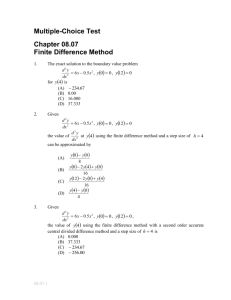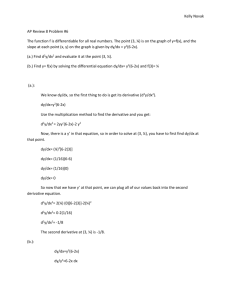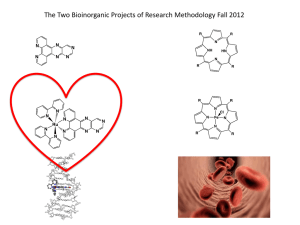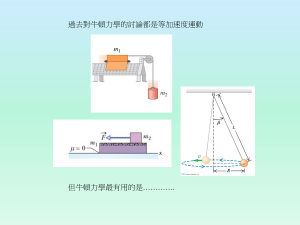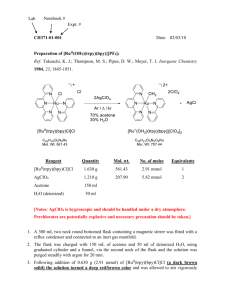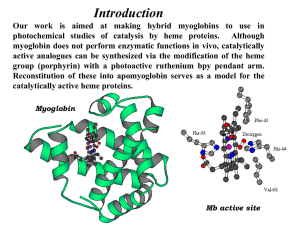Photoredox Catalyst in Organic Chemistry
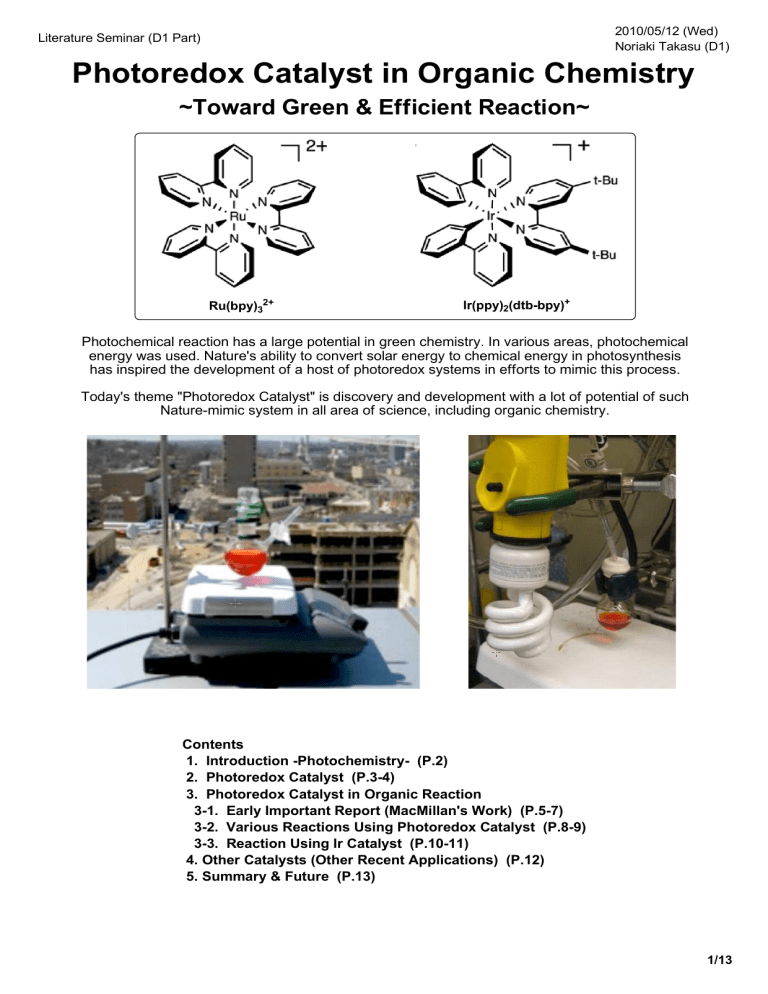
Literature Seminar (D1 Part)
2010/05/12 (Wed)
Noriaki Takasu (D1)
Photoredox Catalyst in Organic Chemistry
~Toward Green & Efficient Reaction~
Ru(bpy)
3
2+ Ir(ppy)
2
(dtb-bpy)
+
Photochemical reaction has a large potential in green chemistry. In various areas, photochemical energy was used. Nature's ability to convert solar energy to chemical energy in photosynthesis has inspired the development of a host of photoredox systems in efforts to mimic this process.
Today's theme "Photoredox Catalyst" is discovery and development with a lot of potential of such
Nature-mimic system in all area of science, including organic chemistry.
Contents
1. Introduction -Photochemistry- (P.2)
2. Photoredox Catalyst (P.3-4)
3. Photoredox Catalyst in Organic Reaction
3-1. Early Important Report (MacMillan's Work) (P.5-7)
3-2. Various Reactions Using Photoredox Catalyst (P.8-9)
3-3. Reaction Using Ir Catalyst (P.10-11)
4. Other Catalysts (Other Recent Applications) (P.12)
5. Summary & Future (P.13)
1/13
1. Introduction -Photochemistry-
Photocatalyst
(ref. Itano's Lit. (M2 Part))
Inorganic Photocatalyst
Photocatalyst is applied to many fields; antibacterial, sterilization, deodorization, antifouling, antifogging, water / air purification...
TiO
2 is employed in most area.
(Semiconductor)
Figure.
Photocatalysis Principle of TiO
2 h electron conductive band e
bandgap energy forbidden band Various
Effect valence band positive hole valence electron excitation by photo energy
(Light Souce : UltraViolet (< 400 nm))
Other Application : water splitting conversion of CO
2 into hydrocarbon
So Important Tool in Our Life
Organic Photocatalyst (Sensitizer)
Most of photo reactions of organic compound undergo in
Triplet Excited State.
Organic
Compound
Singlet Excited State h
(UV) Triplet Sensitizer
Figure.
Example of Triplet Sensitizer
Examples;
O
O
Benzophenone (BP)
NO
2
5-Nitroacenaphthen (NAN)
Triplet Excited State
O
Anthraquinone (AQ)
O
Cl Cl
Cl
O
Chloranil
Cl
Photo Reaction (Photochemistry in Organic Reaction)
Scheme.
Example of Photo Reaction
[2+2] Photocycloaddition
Chem. Rev.
, 2007 , 107 , 2725.
Chem. Rev.
, 2008 , 108 , 1052.
Electron-Transfer Reaction
Intermolecular Addition onto Unsaturated C-C Bond
These reactions' "reagent" is light source.
These are high atom economy and green reaction.
But, Most light source is ultraviolet, which is reactive for unsaturated bond and some functional group, and is not
Nature's light.
Visible light
2/13
2. Photoredox Catalyst
Catalyst that shows oxidative and reductive property by absorbing visible-photoenergy
Most of photoredox catalyst is metal-ligand complex molecules.
Metal : Ru, Ir, Cr, Rh, Co...
Ligand : 2,2'-bipyridine (bpy), 1,10-phenanthroline (phen)...
Among them, Ru(bpy)
3
2+ is most studied one-electron photoredox catalyst.
2-1. Photophysical Property of Ru(bpy)
3
2+ K. Kalyanasundaram, Coor d. Chem. Rev.
, 1982 , 46 , 159.
A. Julis et al.
, Coord. Chem. Rev.
, 1988 , 84 , 85.
Photoabsorption and Excited State
h
Ru(bpy)
3
2+
MLCT
Ru(bpy)
3
2+
* excited state
Metal-to-Ligand Charge Transfer
2+ charge of Ruthenium is transferred to Ligand (trisbipyridine) by photoenergy. so high energy state, triplet excited state.
Figure.
Absorption and emission spectrum for Ru(bpy)
3
2+ in aqueous solution at room temperature along with the assignments for the various bands.
Absorption
MLCT absorption band
Emission
MLCT excited state absorption; max
= 452 nm
Visible Light
By irradiated with visible light,
Ru(bpy)
3
2+ is excited high energy state.
Excited state energy was computed;
E
0
[Ru(bpy)
3
2+/2+
*] = -2.10 V
( vs.
SCE in MeCN)
Energetics of Various Redox State
A.J. Bard et al.
, JACS , 1973 , 95 , 6582.
T able.
Oxidation and Reduction Potential evaluated by Cyclic Voltammetry.
Ox + eRe , E(V)
E > 0 : potent oxidant
E < 0 : potent reductant
+2 state : stable ground state;
+3 state : good oxidant
+1 state : good reductant cf) oxidising water to O
2
(E
0
(O
2
/H
2
O) = +1.23 V
SCE : Saturated Calomel Electrode a reference electrode based on the reaction between elemental mercury and mercury(I) chloride in KCl sat. aq.; use mesurement of Redox potential
NHE : Normal Hydrogen Electrode (= SHE) a redox electrode which forms the basis of the thermodynamics scale of oxidation - reduction potentials; use mesurement of Redox potential
3/13
The excited state redox potentials are obtainable from the redox potentials of the corresponding ground state.
(Probably, the excited state energy is all available as free energy for the excited state redox processes.)
Calculated ( vs.
SCE);
C. Creutz, N. Sutin, Inorg. Chem.
, 1976 , 15 , 496
T. J. Meyer et al.
, JACS , 1979 , 101 , 4815
Figure.
Redox potential diaglam
- 2.10 + 1.29 = - 0.81 V reductant oxidant oxidant reductant
- 1.33 - (-2.12) = + 0.77 V
T able.
Formal Reduction Potentials at Room Temperature ( = 0.1 M) potent oxidant potent reductant
Excited state Ru(bpy)
3
2+
* is good oxidant and good reductant
Redox Quenching of excited state
Table.
Rate parameters in the quenching of Ru(bpy)
3
2+
* by inorganic ions and molecules (k q k
2
; quenching rate constant,
:decrease rate constant of Ru(bpy)
3
2+
* ) generation of singlet oxigen
Several Application (Using Visible Light)
Water split
H
2
& O
2
Production
Reduction of Carbon Dioxide h (400 nm)
Ru(bpy)
3
2+
+ CO
2
N(CH
2
CH
2
OH)
3
-DMF
CO
2
+ 2H
+
+ 2e
-
HCO
2
H E = -0.61 V
HCO
2
H
Ru(bpy)
3
Cl
2 photosensitizer h (400 nm)
Ru(bpy)
3
2+
* proton source
Ru(bpy)
3
2+
* + N(CH
2
CH
2
OH)
3
Ru(bpy)
3
+ reductant
+ N(CH
2
CH
2
OH)
3
Ru(bpy)
3
+
+ 1/2 CO
2 proton source 1/2 HCO
2
H
Ru(bpy)
3
2+
G. Christou et al.
, J. Chem. Soc., Chem. Comm.
, 1985 , 56.
4/13
3. Photoredox Catalyst in Organic Reaction
3-1. Early Important Report (MacMillan's Work)
Background and Consideration
Many fundamental organic reactions rely on the generation and use of radicals or singleelectron intermediates ; metal-mediated reaction, photoreaction, polymerization, etc...
Ru(bpy)
3
2+
: one-electron photoredox catalyst , important development of H
2
,
O
2
, energy storage, etc...
Application as initiator of single-electron intermediates??
On the other hand....
Previous MacMillan's work : organo-HOMO, LUMO, SOMO-activation catalysis (ref. Mihara's Lit. (D1 Part))
D. W. C. MacMillan et al.
, Science , 2007 , 316 , 582.
= Single Occupied Molecular Orbital
SET (Single Electron Transfer)
One-Electron Oxidation
O
5
H Me aldehyde
+
O
N
Me
Me
SiMe
3 allylsilane
+
Ph
N
H
20 mol% catalyst
CAN (2.0 eq)
NaHCO
3
, 24 h
DME, -20°C
88%, 91% ee
H
O
Me
Product
5
Me
In later report...
Many Applications of SOMO catalysis via SET;
Aldol, Friedel-Crafts, Vinylation, Allylation,
Arylation, Enolation, Enal Reduction, ....
See these literature;
JACS , 2007 , 129 , 7004.
JACS , 2008 , 130 , 16494.
JACS , 2009 , 131 , 11332.
JACS , 2010 , 132 , 5027.
JACS , 2008 , 130 , 398.
JACS , 2009 , 131 , 11640.
ACIE , 2009 , 48 , 5121.
et cetera...
In other examples,
-allyl aldehyde was provided in high yield & enantioselectivity.
Me
N
O Me
N
R
1
N
H
HX
R
2 or
R
1
N
H
SET Reagent : CAN, Fe complex
O
HX R 1
, R
2
R
2 = Me, Bn, t
Bu
Suggestion of New Catalytic System
Ru(bpy)
3
2+
Powerful Inorganic
Electron-Transfer
Catalyst
+
MacMillan's Catalyst
Powerful Organic
Enantioselective
Catalyst
Combine
New
Catalytic System
Enantioselective Reaction in Mild & Green Conditions
Merging photoredox catalysis with organocatalysis
5/13
-Alkylation of Aldehyde Using New Catalytic System
Proposed Mechanism (Theoretical Hypothesis)
D. W. C. MacMillan et al.
, Science , 2008 , 322 , 77.
Figure.
Merging Photoredox Cataysis with Organocatalyis. Proposed Mechanism.
H
2
O
SOMOphile
H
2
O
SOMO
E = -0.92 ~ -1.12 V vs.
SCE in MeCN a low barrier to oxidation
Chem. Phys. Lett.
, 1986 , 131 , 189
E = -1.33 V vs.
SCE in MeCN
(potent reductant)
JACS , 1979 , 101 , 4815
MLCT excited state potent oxidant or reductant
Phenacyl bromide was reducted in this reductant.
(Half-reduction potential;
E
1/2
= -4.9 V vs.
SCE in MeCN)
J. Phy.Chem
, 1990 , 94 , 722 light
(photosensitizer)
Start of cycle : 2 (MLCT exited state, high energy intermediate ) removes a single electron from a trace quantify of enamine (slowly) . Generated radical amine quenched in photoredox cycle.
Me
O
N
N
Me t Bu
Ru(bpy)
3
2+
*
2 R
Figure.
Ru(bpy)
3
Cl
2
Emission Quenching by Enamine 8
Me
O
N
N
Me t Bu
Ru(bpy)
3
+
R
3 not participate in reaction
I
0
= Emission intensity of Ru(bpy)
I = Emission intensity of Ru(bpy)
3
2+
3
2+
.
in the presence of quencher.
Small decrease of emission intensity in presence of enamine.
2 behaves as an oxidant, and enamine can be reacted with Ru(bpy)
3
2+
(but so slowly).
Electron-deficient radical 5 is reactive, so it reacts with enamine 8 (fast).
Stereocontrol and reaction surfice control of enamine 8 ;
R Re face covered
Substituent on N is away from vulky tert -butyl group.
O
N
To minimize with non-bonding electron pair, ( E )-configuration.
N
Methyl group effectively shields the Re face.
Enantioselective radical addition from Si face
6/13
Result
O
R
(2 eq.)
+
O
X
Br racemic
Y catalyst combination
1 & 6
15W fluorescent light
2,6-lutidine, DMF
5 - 16 h, rt
O X
R O
Y
O
N
Me
Me
6
N
H t
Bu
HOTf
20 mol% organocatalyst
Ru(bpy)
3
Cl
2
1
0.5 mol% photoredox catalyst
O CO
2
Et
Hex
CO
2
Et a) 93%, 90% ee
O CO
2
Et
CO
2
Et
N
Boc e) 66%, 91% ee
O CO
2
Et
CO
2
Et
3
Et b) 86%, 90% ee
O CO
2
Et
CO
2
Et f) 63%, 93% ee
O CO
2
Et
CO
2
Et
Ph c) 92%, 90% ee
O
Cy
CO
2
Et
CO
2
Et d) 83%, 95% ee
O
Ph
O
Hex O g) 84%, 96% ee
OMe
Hex O h) 87%, 96% ee
O O
Ph
O O
Ph
Ph Ph
83% (1:1 mixture) radical clock substrate
Previous SOMO activation;
O
N
Me
Me
N t Bu active spieces
Enamine is SOMO
R cyclopropyl ring opening
(not undergo)
O
Hex O i) 84%, 95% ee
NO
2 O
OCH
2
CF
3
Hex O k) 80%, 92% ee
O Me
CO
2
Et t
BuO
2
C
CO
2
Et
Hex
O
Hex O l) 80%, 88% ee m) 70%, 5:1 dr, 99% ee
In this reaction systems, enamine is SOMOphile.
(see Proposed Mechanism)
Chemical functionalities that are prone to redox (olefins, esters, carbamates, and arenes) were inert to these mild redox conditions ( b-f ).
Chemoselective Reaction.
Vulkiness of R has little impact of yield & ee.
Electron-deficient -bromo carbonyls effectively serve as alkylating agents ( g-m ).
Tertiary bromo-substituted alkylating agents are readily employed ( l, m ).
A 2g alkylation was readily accomplished ( g ).
Exclusion of light failed to produce even trace quantities of the coupling adduct.
Removal of Ru(bpy)
3
2+ resulted in small quantities of product (24 h).
Light source tuned to the Ru(bpy)
3
2+
MLCT absorption band resulted in a acceleration (90 min).
Participation of the
Ru(bpy)
3
2+
* excited state
It does not require any heating or cooling, all of the components are commercially available and inexpensive.
Simple household 15-W fluorescent light bulb can be employed as a suitable light source Visible Light
Chemoselective Reaction, and Decrease of Side Reaction diastereoselectivity of m ;
R
O
N
R' N
O
R
O
R'
N
N
O
7/13
3-2. Various Reactions Using Photoredox Catalysis
Reductive Dehalogenation
Classical Method
Cl Cl
N
Bu
3
SnH, AIBN
N
NH
Br
C
6
H
6
, reflux
99%
NH
Or g. Lett.
, 2005 , 7 , 2965.
Using trialkyltin, toxic and environmental pollutants.
Using Photoredox Catalyst (Tin-Free Method))
Intramolecular Radical Addition (Tin-Free)
C. R. J. Stephenson et al.
, Org. Lett.
, 2010 , 12 , 368.
Scheme.
Intramolecular Radical Addition of Indole and pyrrole
N
Br CO
2
Et
CO
2
Et
N
Br CO
2
Et
CO
2
Et
Ru(bpy)
3
Cl
2
(1 mol%)
Et
3
N (2 eq)
15W fluorescent light
DMF, rt, 12 h
73%
Ru(bpy)
3
Cl
2
(1 mol%)
Et
3
N (2 eq)
15W fluorescent light
DMF, rt, 12 h
80%
N
N
CO
2
Me
CO
2
Me
CO
2
Me
CO
2
Me
C. R. J. Stephenson et al.
, J. Am. Chem. Soc.
, 2009 , 131 , 8756.
Scheme.
Reductive Debromination
Br i
Pr
2
NEt (10 eq), HCOOH (10 eq) (90%) i
Pr
2 or
NEt (2.0 eq), Hantzsh ester (1.1 eq) (95%)
N
Boc
H
N
Boc
Ru(bpy)
3
Cl
2
(2.5 mol%), 14W fluorescent bulb
DMF, rt, 4 h
H
N
Boc
H
N
Boc
Other several examples was performed, in moderate - high yields.
T able.
Reductive Dehalogenation Using Photoredox Catalysis
Single Diastereomer
MeO
2
C
MeO
2
C
H
H
H
N
Scheme.
Proposed Mechanism
X
3 : Hantzsh ester
R
1
R
2
H
R
1
H
R
2
Various chemical functionalities were inert to these redox conditions.
Tin-Free, and mild conditions cyclopropyl (radical clock) : opening ring
O
O
O
O
O N O N
Br
Ru* - Amine electron transfer was reported;
JACS , 1979 ,
101 , 4007
8/13
[2+2] Cycloaddition (Enone Cycloaddition)
Previous Method (Kirsche)
R = 2-naphtyl
R = phenyl
0%
12%
90%
43%
Slow addition (60 s) of Me
2 of substrate (100 mol%)
CuLi (25 mol%) to a solution
J. Org. Chem , 2004 , 69 , 7979.
J. Am. Chem. Soc , 2002 , 124 , 9448.
Problem of these reaction systems; Chemoselectivity, Yield, Narrowness of sabstrate scope
New Method Using Photoredox Catalyst T. P. Yoon et al.
, J. Am. Chem. Soc.
, 2008 , 130 , 12886.
R
O
Table.
O
R'
Ru(bpy)
3 i Pr
2
Cl
2
(5 mol%)
NEt (2.0 eq)
LiBF
4
(2.0 eq)
275W floodlight
O
R
H
O
H
R'
Visible Light Photocatalysis of Enone Cycloaddition a
Aliphatic enone and enoate do not cyclize ( entries 5, 6 ) because of more negative reduction potential
R e
R
O O
JACS
E
1/2
(V) vs .SCE : R = Ph > Alkyl Alloxy
, 1972 , 94 , 8471.
no reaction in the absence of i
Pr
2
NEt
Cycloaddition is not directly initiated by Ru(bpy)
3
2+
*,
Ru(bpy)
3
+ formed by reductive quenching of amine.
no reaction occurs in the absence of LiBF
4
Ru(bpy)
3
Cl
2
: sparingly soluble Ru(bpy)
3
(BF
4
)
2
: soluble
Na
+
, Bu
4
N
+
: low reactivity Li
+ cf.
Ph
H
Ph
COPh is involved in reaction.
E
1/2
= -1.58 V ( vs.
SCE)
Ru(bpy)
3
+
So, Li
+
: lack of reductive power is essential
Scheme.
gram scale
Scheme.
Proposed Mechanism
Yoon, JACS , 2009 ,
131 , 14604
O
O i
Pr
2
NEt
R
R' e
-
O
O
R
R'
O
O
R
R'
O
O
R
R'
9/13
3-3. Reaction Using Ir Catalyst
Ir(ppy)
2
(dtb-bpy)
+
Ir(ppy)
2
(dtb-bpy)
+
S. Bernhard et al.
, J. Am. Chem. Soc.
, 2004 , 126 , 2763.
S. Bernhard et al.
, J. Am. Chem. Soc.
, 2004 , 126 , 14219.
Various Ir photoredox catalyst was synthesized and investigated property;
It readily accepts a photon from a visible light, and excites.
high reductive ability of one-electron oxidative state
Ir(ppy)
2
(dtb-bpy)
+ stable ground state visible light
MLCT
Ir(ppy)
2
(dtb-bpy)
+
*
3
MLCT excited state oxidative quenching
Ir(ppy)
2
(dtb-bpy) one-electron oxidative state
E = -1.51 V vs.
SCE in MeCN potent powerful reductant
Aza-Henry Reaction via C-H Activation
C. R. J. Stephenson et al.
, J. Am. Chem. Soc.
, 2010 , 132 , 1464.
Table.
Oxidative Iminium Ion Generation and Trapping Table.
Oxidative Aza-Henry Reaction
15W fluorescent lamp, open to air
3 : Ru(bpy)
3
Cl
2
.
Reactivity : Ru cat. < Ir cat.
Scheme.
Plausible Mechanism lack of O
2 decrease of reactivity open to air.
Although the process was slowly, C-H oxidation of a nonbenzylic amine afforded (entry 9).
Although reaction using Cu(I) and TBHP is faster than these reactions (ref.
JACS , 2005 , 127 , 3672), these reactions provide desired products in higher yields.
10/13
-Trifluoromethylation of Aldehyde
D. W. C. MacMillan et al.
, J. Am. Chem. Soc.
, 2009 , 131 , 10875.
T able.
Enantioselective -Trifluoromethylation: Initial Studies T able.
Enantioselective -Trifluoromethylation: Aldehyde Scope
Yield of the corresponding alcohol.
Racemization was detected in room temperature, but in low temperature, racemization was not detected.
Reactivity and selectivity : Ru cat. < Ir cat.
Scheme.
Proposed Merger of Catalytic Cycles for CF
3
-Alkylation
T able.
Enantioselective -Perfluoroalkylation: Alkyl Iodide Scope
E
1/2
= -1.21 V vs SCE in DMF
11/13
4. Other Catalysts (Other Recent Applications)
Ru-Pd complex (Dimerization of Methystyrene)
M. Akita et al.
, Chem. Comm.
, 2005 , 5468.
M. Akita et al.
, Inorg. Chem.
, 2007 , 46 , 2432.
Scheme .
Proposed Mechanism
Scheme .
Transition-metal complex containing a visible-light-absorning unit
Solv.: acetone
2 cat.Ru-Pd
150W Xe lamp
(> 420 nm)
CH
3
NO
2
, rt
90%
Figure .
Consumption rate of the monomer in the reaction of 9-11 under irradiated conditions.
Cr Complex
J. M. Kelly et al.
, Dalton T r ans.
, 2010 , 3990.
strongly binding and interact with DNA
Phosphorescence of complex is efficiently quenched.
[Cr(phen)
2
(X
2 dqqz)]
3+
When it binds with DNA, it shows property to photoenergy.
Potential as nucleic acid probes
12/13
5. Summary & Future
conserves energy in absorbing visible light, and functions development in the field related to the environment.
After that
In organic chemistry, using this catalyst, radical-mediated efficient and green reaction was developed. However, application examples is still few.
Next study
Development of more efficient catalyst (Metal, Ligand, ...)
Expand of this catalytic system in many fields (In organic reaction, new radical-reaction)
And...
Thess "efficient and chemoselective" methodology represents a potential means for accessing a variety of medicinally and biologically active natural or non-natural products.
Synthesis of Complex Molecules
13/13
